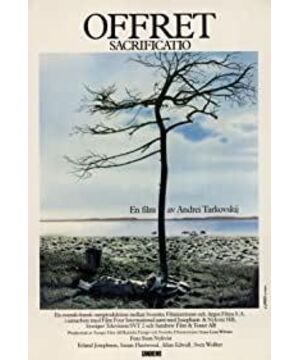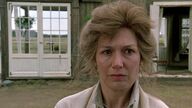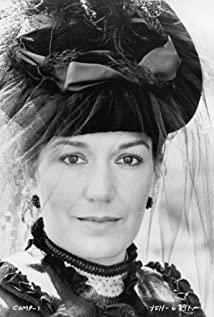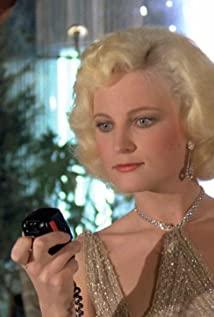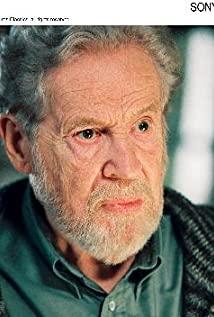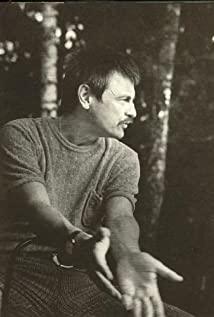"Sacrifice" is not a movie that makes people understand eight or nine points at a glance. In fact, after everyone watched "Sacrifice", they were at a loss, and they didn't understand what it said. But this is not the first time that Andrei Tarkovsky has given this kind of inexplicable feeling. Tashi made a total of seven feature films in his life, all of which are probably masterpieces that make people struggle between sleep and waking, ignorance and understanding, love and hate, and even life and death, all of which torment the hearts of the Soviet public. One audience member even unceremoniously called his film "pointless, it doesn't reach the audience at all" after watching his film, and his anger was almost instantaneous. In short, making a movie like Tarkovsky is indeed thankless, others are distressed, and even more distressed.
"The Sacrifice" is Tarkovsky's last work. It is said that before the enlightened monks foreshadowed that they were about to pass away, they often did not eat or drink for ten days and a half, in order to remove the filth from their bodies and leave a body Buddha for people to look up to. Film masters are similar; of course, it doesn’t matter to them whether the physical body can stay or not, they just use their last time on the earth to work hard, express what they have learned in their life, and make a film. The mythical works of art are handed over to the world for comment. Yang Dechang, Leone, Ozu Yasujiro, Kieslowski, all of them. Did they leave because they were too forceful and exhausted, or did they fly into the kingdom of heaven because they fulfilled their mission on earth? No one will look into such things.
Let's just take these as some kind of "coincidence". However, "Sacrifice", Ta's last work, was no accident. In his work "Sculpting Time" and in his personal diary, Tarkovsky made it clear that the original conception of "Sacrifice" came earlier than the previous work "Nostalgia". Although the original idea was very different from the final film, in a way, it was "Sacrifice" that influenced "Homesickness", rather than the previous work that triggered the later work. Not only that, but Tarkovsky deeply felt that although he was in exile in a foreign land, "my basic beliefs have not changed in the slightest, and not only have I progressed, but also deepened and strengthened." From this point of view, Sacrifice is the culmination of Tarkovsky's late style and the perfect ending to his artistic career.
one
If there is any "plot" in "Sacrifice", it should be as follows: On the birthday of the protagonist Alexander, he and his family heard the bad news of the third world war. In order to save his loved ones from disaster, and also to prevent the world from falling into the abyss they dug themselves, Alexander did everything in his power to dedicate himself to God. The so-called "sacrifice" in the title is exactly what it means.
Why sacrifice yourself in exchange for the happiness of others? Can sacrificing oneself really bring about the happiness of others? Do you have to sacrifice yourself in exchange for the happiness of others? ...there will undoubtedly be a string of unanswered questions about the most basic values in the film. In fact, every detail in the film, even from the first second of the whole film, Tarkovsky gave infinite hints and possibilities, their appearance is not a coincidence, nor can it be said in one word its symbol. They are more like fragments, which organize the situation of the story, outline the direction of the story, and even directly declare the authenticity and reliability of the simultaneous existence of the story in different time and space. It seems to suggest that Tarkovsky is only humbly acknowledging that he is the storyteller, not the creator.
Before the feature film started, Leonardo da Vinci's famous work "The Doctor Comes to Worship" appeared on the screen impressively. Tarkovsky's love for Leonardo da Vinci has a long history. In his own words, in front of Leonardo da Vinci's paintings, "our intellect and emotion tremble with joy", while his first In the four works "Mirror", the men and women of Leonardo da Vinci appeared more than once. Ta's love for the mysterious and moving paintings of Leonardo da Vinci, "The Doctor Comes to Worship" certainly has this quality. Even today, people still do not understand how the image in this painting corresponds to history or the "Bible" characters in. In addition to the style, the meaning of the painting itself is even more in line with Tarkovsky's idea - the so-called "worship of the Magi" refers to the request of King Herod when Jesus came to the world described in Matthew's Gospel. The visit of the three wise men to Bethlehem.
The camera moves up from the Doctor holding the frankincense, skips the Holy Child and the Virgin, and finally falls on the canopy of a tree, which is connected to a dead tree planted by Alexander and his son in the first shot of the feature film. Accompanying the camera is the mezzo-soprano aria "My God, have mercy on me for the tears I shed" from Bach's most famous work, the Passion of Matthew. By presenting such a picture, the meaning of the film has actually become vaguely clear: what "Sacrifice" tells is actually an ancient story in a modern context, a fable of faith that sees suffering and redemption as one. .
As for the dead tree, it is the core image that connects that time and this moment. In the film, Tarkovsky interprets the mystery of Leonardo da Vinci through the mouth of Alexander, extending the connotation of "The Doctor Comes to Worship" - in the legend, a monk waters the dead tree every day, believing that he Faith in God has magical powers. In the end, he lived to witness the dead tree covered with young leaf buds - just like the end of the film, Saint Alexander had collapsed, and his son was watering the dead tree as always, convinced that the legend of "the dead tree blooming" Tragic hope.
two
Tarkovsky's exile was somewhat unusual: he was forced to leave his homeland not because of his political views, but because of his artistic views and the leftward movement of the Soviet authorities. This is also the main reason why Ta's spirit and body went into exile together, or even earlier than the former. On the one hand, he was deeply distressed by the denial and bullying of the filmmaking methods of Tarkovsky's aesthetic concept (he repeatedly alleged in his diary that Sergei Bondarchuk, who directed "War and Peace", was Jean "Nostalgia" was not selected for the Palme d'Or at the Cannes Film Festival, and in fact, Bondarchuk was indeed the judge of that year, and there was a deep conflict between the two); the deeper problem is that Tarkovsky insisted The concept of belief was indeed incompatible with the communist ideology of the Soviet Union at that time.
If Tarkovsky in his early "Andrei Lublev" also displayed the greatest tolerance for the modern concept of the nation-state-war tragedy, "Stalker" is the The largest compromise (or break) reached between the Soviet Union and the Soviet authorities on the premise of "no exile". It was during this filming that Tarkovsky found that his film had been repackaged and had to re-shoot most of the film in extreme crash conditions. After this, Tarkovsky began his exile journey, which also officially opened Tarkovsky's larger narrative of human tragedy.
As mentioned earlier, classical aesthetics, especially the religious art and music of the Renaissance, are indeed important references for understanding Tarkovsky's films. But in parallel with it, Tarkovsky's views are also deeply rooted in the reality of the Soviet Union, and his worries about modernity and his admiration for the classics can be described as "two sides of the same body". Tashi firmly believes that the development of industrialization has led to a series of modernization problems. With the continuous expansion of material desires, human beings have fallen into irreversible arrogance, and "belief" has become an ability that people have lost (Stalker Language). ). From "Stalker" to "Nostalgia" to "Sacrifice", Tarkovsky used the length of three films to discuss the above issues, which shows its unparalleled importance to Tarkovsky. In these three films, Tashi has experienced three thought processes successively: from "believing", to "deepening from belief to daring to sacrifice", until finally "taking the initiative to sacrifice", that is, when "Sacrifice", Ta The protagonist of Kowski has finally reached the level of the saints, reaching the highest spiritual realm in the context of Western religions.
From the West to Russia, the "sacrifice" complex of the characters in Tarkovsky's films is usually shown in the image of "Holy Fool" with a rather mystical temperament. The Holy Fool is the specific image of the saints in the Eastern Orthodox Church. They are described as sloppy and confused, but they can often save people from misfortune and fire, and thus become the object of worship. Characters based on this image exist in several important works of Tarkovsky. They are either the protagonists themselves - such as Stalker and Alexander in "The Sacrifice"; Important factors - like Dominic in Nostalgia. In Tarkovsky's heart, it is these lunatics who seem to be easy for ordinary people to hold the key to the temple of faith, the scepter that can save all beings from depravity and suicide, and the door to the last hope of mankind. Interestingly, Swedish actor Erland Josephson played a madman in Tarkovsky's films twice in a row. Although the two have different occupations, their status is surprisingly consistent, enough to become a glimpse of Tarkovsky's "Holy Fool". An interesting pathway to the concept of salvation.
three
Tarkovsky's last work was filmed in Sweden, far from home. Fortunately, Ingmar Bergman, who spoke highly of Tarkovsky, offered his own team, especially the addition of Bergman's royal photographer Sven Newkvest, adding to Tarkovsky's work. Into a never-before-seen Swedish/Bergman chill.
Of course, if it weren't for Tarkovsky's strong control and high reputation, I'm afraid this sacrificed boat would still "turn over": just look at Bergman's work of the same period "After the Rehearsal" Or "Fanny and Alexander," and you'll see how different the two's camera language is, especially when it comes to the tone of the film. According to Newkvest's recollection, Tarkovsky reduced color by 60% to some scenes in "Sacrifice", which is quite different from Bergman, who is very good at warm colors. The way of color tells the bleakness and hopelessness of the world, and highlights the tragic and solemnity of Shengyu as "a true warrior who dares to face the bleak life", while the latter deliberately strengthens the surging torrent in his heart with a blank face. Interestingly, the two eventually reached the same destination, discussing human suffering and extraordinary struggle. No wonder the two cherished each other, but never dared to see each other - what a subtle combination of tacit understanding and opposition.
The most interesting thing about "Sacrifice" is undoubtedly the six-and-a-half-minute, heart-wrenching scene near the end. During the first filming, the camera was stuck in the middle. The accident not only destroyed the film, but the entire crew had to watch the house in front of them burn to ashes, and four months of hard work turned into a wisp of smoke. The seriously ill Aries director suddenly fell into despair, but at this time he received the full support of the entire cast and production team. Just two weeks later, a very valuable, identical house was erected. This time, two cameras were placed side-by-side on the track to shoot at the same time, until the entire film reached its extreme length of six and a half minutes, and the shot came to a perfect abrupt stop. The entire crew hugged each other tightly, all crying like a child.
And the next time I am so sad and happy, it will be over Tarkovsky's funeral. Less than eight months after the release of "Sacrifice" in Sweden, that is, on December 29, 1986, the poet's son, film lover and creator, who left the world with endless moving and shocking masters, passed away at the age of 54. At his funeral, Bach's music continued, one after another.
Five years later, the Soviet Union disintegrated with the same sadness and joy.
View more about The Sacrifice reviews


